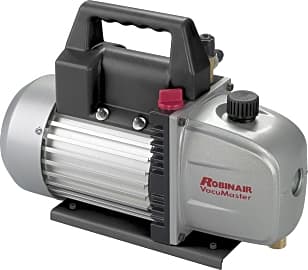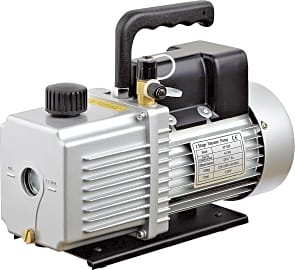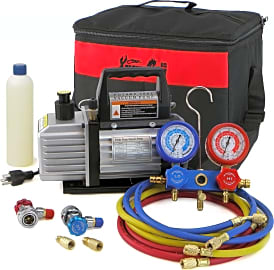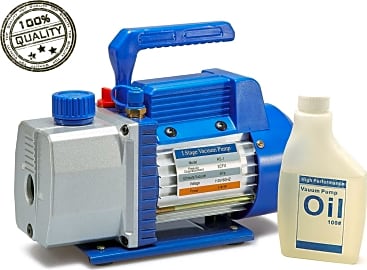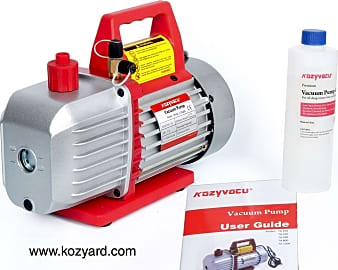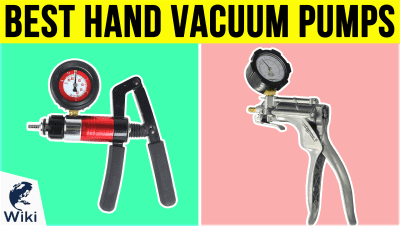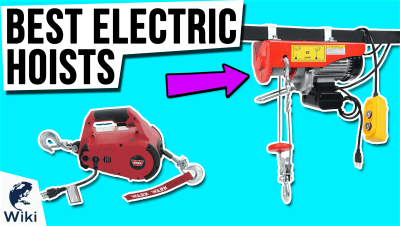The 9 Best Vacuum Pumps

This wiki has been updated 40 times since it was first published in February of 2015. For any application that requires the evacuation of air or other gas molecules, including preparing air-conditioning systems before charging, automotive maintenance and repair, and degassing wine, you'll need one of these sturdy and reliable vacuum pumps. We've made it easy to select the right model for your requirements by assessing each one's capabilities and value for money. When users buy our independently chosen editorial choices, we may earn commissions to help fund the Wiki.
Editor's Notes
March 10, 2021:
The major change I’ve made during this update was removing a couple of the outdated two-stage models from the brand Yellow Jacket, and adding some newer and more economical replacements in the Vivohome VP245 and Kozyvacu TA500, although the Yellow Jacket models did have slightly higher CFM rates – these pumps have rates of 5 CFM. I’ve also added a couple of newer single-stage, like the NewPosition RS-1 and Robinair VacuMaster. We did also have a single-stage Kozyvacu model, though I’ve removed that. The Hardware Factory Store VP1200 still has the highest CFM rating on this list, while the other pumps can push between 3-5 cubic feet per minute - in fact, the two single-stage models I've added push 3 CFM, while the rest have a 5-CFM rating.
July 09, 2019:
The Mityvac Silverline Elite joins the selection in this update, as a convenient, handheld model made of zinc alloy die cast metal for durability. Its easy-to-read gauge is graduated in both inches and centimeters. It’s part of an automotive kit that includes a pump reservoir jar, brake bleeding adapter package, test adapter package, rubber cap adapter, and tubing. This selection helps to make quick work of jobs such as tune-ups and engine diagnostics. Since it’s handheld, it helps make your work into a one-person job, and its swivel feature is useful when you’re working in tight spaces. All the components fit neatly into the included carrying case. This choice is designed and quality tested in the U.S.A., and you’ll receive a set of thorough, complete instructions.
Retaining its top spot is the Robinair 15500 VacuMaster, which is a powerful, two-stage model that pulls up to 30 inches of mercury. It’ll hold up for years of use, thanks to its thermally protected motor, inlet fitting that’s engineered for maximum airflow, and sturdy non-skid feet. Another high-performing model featured here is the Kozyvacu TA350, which can be purchased by itself or as part of a kit that comes with a manifold, gauges, and a storage bag. You won’t need to worry about running out of oil, since its window makes it easy to quickly check the current level. It also features a tough cast aluminum build and integrated cooling system.
When deciding on a vacuum pump, consider factors like whether you need a one- or two-stage model; while both of these use an initial stage to establish the vacuum, the latter features a second stage for greater draw and a tighter vacuum – which translates to fewer impurities in the system. Other factors to consider include a pump’s CFM rating, as well as whether it safeguards against surges and backflow. If you plan to transport this device from job to job, you might benefit from a hand vacuum pump, which is compact and therefore highly portable. Additional helpful features include a window for viewing the oil level (present on the Kozyvacu TA350 and the Yellow Jacket 93600, both featured here), as well as large, well-placed ports for refilling oil quickly and free of spills. Fortunately, they come in a wide range of prices, so you’re likely to find one that meets your budget.
Special Honors
Becker Industrial Vacuum Pump This highly customizable selection is available in oil-less and oil-flooded options. The former are self-lubricating, rotary vane pumps that operate on a continuous basis and are equipped with a high-efficiency, flange-mounted electric motor. They’re designed for graphic arts, packaging, robotics, and other applications where oil or water is not desirable. The latter are made with oil-flooded rotary vane designs that feature an oil reservoir, oil separation systems, and direct-drive motors. They’re well-suited for thermoforming, food processing, and medical and surgical applications. beckerpumps.com
A Brief History Of The Vacuum Pump
He commissioned Galileo to explore the problem and, hopefully, find a way to solve it.
The suction pump was the precursor of the vacuum pump and is responsible for prompting the research that led to its development. The invention of the suction pump dates all the way back to the ancient city of Pompeii, which was founded in in the sixth or seventh century B.C. Suction pumps were also used in Arabia in the 13th century and later in Europe during the 15th century.
In the 17th century, as suction pumps become more and more powerful, scientist began to look at what was happening to the air after water was sucked out. All they knew at the time was that pulling water beyond a certain height with suction pumps was impossible. This limit, which was roughly 25 to 30 feet, was causing considerable problems for mine drainage, irrigation projects, and decorative water fountains that the Duke of Tuscany was planning. He commissioned Galileo to explore the problem and, hopefully, find a way to solve it.
It took the input of various other scientist to get to the bottom of what was happening. The first step was for Gasper Berti to reproduce the problem in 1639 using the first water barometer. Unfortunately, while he could reproduce it, he couldn't explain it. Four years later in 1643, a breakthrough was made by Evangelista Torricelli. He built the world's first mercury barometer and argued that the space left after the mercury was pumped out was a vacuum.
The first actual vacuum pump was created in 1654 by Otto von Guricke, and he used it to conduct the famous Magdeburg hemispheres experiment. In it, he demonstrated the power of atmospheric pressure by showing that two hemispheres, which had their air evacuated, could not be pulled apart no matter how much force was applied. He used two teams of horses pulling in opposite directions to illustrate his point.
Von Guricke's vacuum pump didn't capture the imagination of scientists, and the technology wasn't pursued until much later in 1855, when Heinrich Geissler invented the mercury displacement pump. His displacement pump created a record vacuum of roughly 10 Pascal units (Pa) and spurred renewed interest in vacuum pump technology, which led to the creation of the vacuum tube.
Understanding The Types Of Vacuum Pumps
While there are many different designs of vacuum pumps, they can be broadly categorized by the principle they make use of: positive displacement, momentum transfer, or entrapment.
Entrapment pumps work by using chemical reactions to create vacuums.
The principle behind a positive displacement pump is that increasing the volume of a container can create a partial vacuum. One can then continue to evacuate the chamber without having to continually grow the container in size, by closing off the suction section of the chamber, evacuating the air, and then expanding it again. This creates a pressure differential which sucks air or gas in to fill the void.
Momentum transfer pumps make use of positive displacement pumps, but add momentum to the mix. Inside of a momentum transfer pump, gas molecules are accelerated as they travel from the vacuum side to the exhaust side. The exhaust side will often have a positive displacement pump maintaining the air at a reduced pressure. Momentum transfer pumps are best used at specific pressures and are not possible below pressures of 0.1 kPa. They are governed by the laws of fluid dynamics and their functionality is dependent on how molecules interact with each other. At atmospheric pressures, or in very mild vacuums, molecular pumping is more effective than positive displacement pumping.
Entrapment pumps work by using chemical reactions to create vacuums. Since the entire process takes place inside the area being vacuumed, they can be more effective. Entrapment pumps remove a thin film that is created by molecules in the air when they chemically react to some of the pump's internal surfaces. They are often used in conjunction with momentum transfer and positive displacement pumps to create ultra high vacuum chambers.
The Many Uses For Vacuum Pumps
Vacuum pumps may seem like something that only scientists and those working in certain industrial applications make use of, but this is entirely untrue. You probably interact with over a dozen mechanisms making use of some kind of vacuum pump each day without knowing it. Your car's door locks make use of a vacuum-based functionality as do hydraulic brakes. As you probably guessed, your vacuum cleaner has a vacuum pump inside, which is what is responsible for creating the suction.
Your car's door locks make use of a vacuum-based functionality as do hydraulic brakes.
Vacuum pumps are used in a number of different medical procedures such as pharyngeal aspiration, pleural suctioning, and subglottic secretion removal. They can be used in a variety of automobile applications where they can help to add horsepower, keep oil cleaner, and increase the life of an engine.
You'll often find them in laboratory settings where they may be used to evaporate and condense solvents from biological samples, vacuum concentrated samples for research, or aid in cell harvesting, tissue culture, and freeze-drying.
While the vacuum pump may have originally been intended to aid in the movement of water and overcome the limitations opposed by atmospheric pressure, it has become an essential piece of equipment in thousands of other applications.





